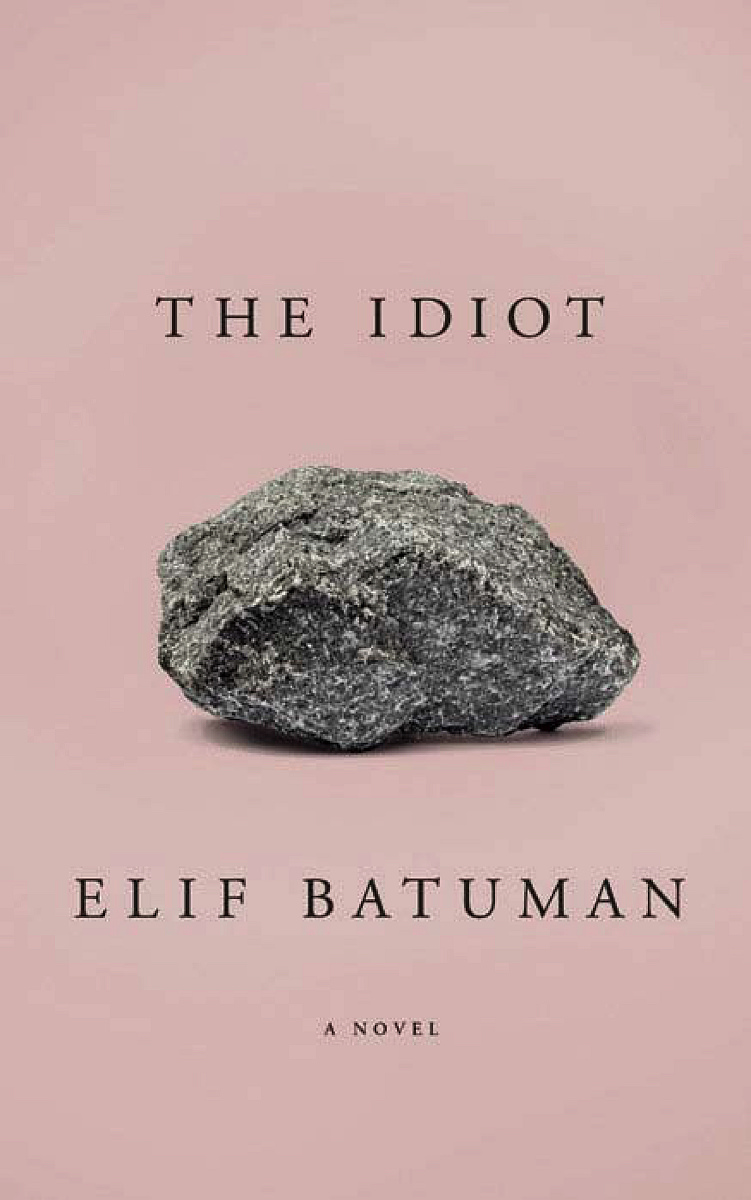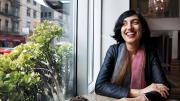References to Harvard crop up everywhere: in films, in television shows, and in a great deal of contemporary literature. Hollywood filmmakers and respected novelists, from James Bridges to Zadie Smith, have returned to the same storied Cambridge sites: the Widener steps, the Johnston Gate, Memorial Hall, Harvard Yard. The substantial corpus of Harvard-themed literature is the subject of my undergraduate course on “The Harvard Novel.” We read novels where Harvard offers a narrative setting, such as The Bostonians (1886) by Henry James, Litt.D. 1911, or supplies a character’s backstory, as in the unpublished “A Fellow at Harvard” (1892) by W.E.B. Du Bois, A.B. 1890, Ph.D. ’95, or operates as a character in its own right, as with Everything I Never Told You (2014) by Celeste Ng ’02 (see “Finding Another Way,” November-December 2022, page 53). To this tradition, Elif Batuman ’99 has contributed two recent works: The Idiot (2017), which introduced the Harvard freshman Selin Karadağ on her first day on campus, and now, Either/Or, a sequel that takes us into her sophomore year.

In my class, The Idiot is a student favorite. The course, like the novel, perhaps, risks appearing like another exercise in Cantabrigian vanitas. In writing about Harvard, or Harvard novels, the trap of self-indulgence is impossible to escape. But those who pass through the University have a responsibility to take its depictions seriously, to think about the urban and geopolitical consequences of its presence, to look closely at the laborers who make its landscape lush and its edifices sparkle, and to examine the relation between creativity and place.
So many enduring novelists and literary characters have strolled through campus: William Faulkner’s Quentin Compson, for instance, in The Sound and the Fury (1929), kills himself on the Anderson Memorial Bridge, finally putting his Harvard education to use by calculating the size of the weights that he will need to drown himself in the Charles River, as Faulkner sardonically quips. Perhaps equally sardonically, the uniform donned by Offred in Margaret Atwood’s The Handmaid’s Tale (1985), set amid the dystopian future of the former bastion of the New England Puritans, invokes crimson Commencement regalia. But few have as effectively turned the notorious campus bubble into an existential Petri dish as The Idiot and Either/Or. It is as if Harvard is for Batuman (who is known for her academic satires and provocative essays in n+1, Harper’s, and The New Yorker) what the French bourgeoisie was for Proust: a micro-society whose insular intensity affords a keyhole view into the elitist foibles of humanity.
The Idiot in fact opens with an epigraph from Proust, who wrote that “adolescence is the only period in which we learn anything.” But it ends with Karadağ’s rueful assertion that her courses had let her down: “I hadn’t learned what I had wanted to learn about how language worked,” she says. “I hadn’t learned anything at all.”
After I reach that concluding sentence with my students, I ask them to keep going to find the book’s actual final page, where Batuman’s acknowledgements proclaim, “Working on this book has made me increasingly conscious of the debt I owe all my teachers, particularly those I encountered in my first year of college. I didn’t always believe it at the time, but they were basically right about everything.” Could Karadağ have been wrong about not learning anything? Batuman’s summation testifies to the impossibility of knowing in the present which influences and experiences will last. (Of course, I have a vested interest in pointing this out; as I tell my students, learning is like happiness: as soon as you try to notice it, it escapes.)
The Idiot ends with Selin Karadağ disillusioned educationally and in romance. But in the opening pages of Either/Or, she has fallen back through the Harvard looking glass. Academia’s condensed, topsy-turvy temporality structures the book: “How brief and magical it was that we all lived so close to each other and went in and out of each other’s rooms, and our most important job was to solve mysteries.” The course catalog, that most prosaic of documents, is “a magical book. All human knowledge was in it, hidden in the form of its classification.”
The faculty, like the creatures populating Alice’s Wonderland, appear faintly ridiculous, each stubbornly pursuing his or her own idiosyncratic hobbyhorse and logic. Yet, with satire comes appreciation. In Karadağ’s course “COMP LIT 140: Chance,” which she discovers, fittingly, through flipping the course catalogue to a random page, the lectures sometimes go over the students’ heads, but “every now and then a sentence jumped up and seemed to sparkle midair.” She survives her sophomore year and, in the concluding section, departs on a summer trip overseas, where the frenzied pace of the semester gives way to the languor of jet lag, unreliable busses, and late, humid encounters. But even on the Anatolian peninsula, Harvard never entirely disappears. Turkish locals recognize the prestige of Karadağ’s institutional affiliation, reminding her of her comparative good fortune.
Like a set of Russian dolls, Batuman’s novel contains nested Harvard novels within its form. In the Widener stacks, Karadağ encounters Elizabeth Wurtzel’s memoir Prozac Nation (1994), also Harvard-based. Like Wurtzel ’89, Karadağ experiments with antidepressants (in her case, Zoloft), and when she peruses some reviews of Wurtzel’s memoir in the basement of the library, they hit close to home: “there was something newly troubling to me…in this story of a girl who had gone to Harvard, and was depressed because her parents were divorced, and had written a book that was widely critiqued as self-indulgent.”
Of course, such concerns about self-indulgence have seldom deterred the male authors who have been writing about their Harvard malaise for over a century. Because the University was slow to admit women, first annexing them at Radcliffe, which only formally merged with the College in 1999, the Harvard novel is traditionally dominated by men. Early Harvard stories by Owen Wister, Charles Flandrau, Thomas Wolfe, and George Santayana tended to revolve around homosocial campus antics: “a multitude of lusty young men linked together by the indissoluble bonds of class and college, all striving, shoulder to shoulder, for the same ends,” as Flandrau put it.
But the threat of isolation dominates even these early narratives. As he begins his sophomore year, Flandrau’s Hewitt, a character from Harvard Episodes (1897), laments that the University has not turned out to be the Edenic scene he had (naively) imagined. “Do you think that Harvard is fair, and do you think it is American?” Hewitt asks his friend Curtiss. On Harvard’s fairness, Curtiss responds that it depends on who you ask, but he adds, “of course it’s American, horribly American, deliciously American!” For Hewitt, outsiderness means the stigma of not being a local Bostonian, and of his “chronic red hair,” while for Henry Adams, A.B. 1858, before him, attending Harvard in the years before the Civil War, as was his family tradition, diversity on campus consisted of the mixing of men from Northern and Southern states.
In Harvard literature, parental agon is a common theme. As Batuman wryly notes, “Half the people at Harvard, within five minutes of meeting you, they were telling you about the influence of their parents.” In Erich Segal’s Love Story (1970), the third-generation Harvardian Oliver Barrett walks through the Yard complaining to his working-class Radcliffe girlfriend Jenny outside “Barrett Hall” about the oppressive influence of his father the Rhodes Scholar. In Ng’s Everything I Never Told You, all the racial and gender prejudice James and Marilyn suffered at the University (James is denied tenure for being Asian American and Marilyn is the only woman in her science lab) is inherited in troubling ways by their children. Even Selin Karadağ cannot shake free of the thought of her parents who immigrated from Turkey, who sacrificed so she could soar. As she explains of her Harvard admission, “My mom said that my getting in proved that she could have gotten in.” Unlike her enervated antecedents (“no one took Harvard College seriously,” Henry Adams remarked), Karadağ is determined to wrest everything she can from her campus experiences.
Since Adams’s time, the Harvard novel, like the campus itself, has today become considerably more inclusive, and, as Either/Or indicates, some of the most exciting contemporary Harvard literature is being written by women. One of Karadağ’s most appealing qualities is her mistrust of the inherited ways of organizing literature, academia, and biological experience. She is dubious that the best way to structure a woman’s life is necessarily by marriage and childrearing, just as she questions the usefulness of dividing knowledge into categories like anthropology, science, and religion: “Why was the history of non-industrial people in anthropology, and not in history? Why were the most important subjects addressed only indirectly? Why was there no department of love?” One of the book’s best zingers is directed at English professors, who will “only be happy when they had translated every miraculous book into a product of its historical moment.”
Part of what Karadağ gains at college is a kind of anti-knowledge. Ivan, her love-obsession in The Idiot, is writing a thesis on the mathematical concept of the “random walk”: “If you were standing at a tree and started taking steps in random directions, you would eventually end up back at the tree,” as Karadağ explains. The idea becomes a metaphor for the book’s meandering structure, linked to Batuman’s broader exhortation to write “long” and “pointless” novels. But the celebration of aimless drifting is also a retort to a competitive campus culture. As Either/Or expands, “Telling jokes—like getting in arguments, or playing ping pong—was one of the many seemingly casual and non-professional human activities that turned out, in college, to be a rigorous, technical discipline that some people studied day and night, and pursued to a competitive career path.” That might be true to a degree of any college, but it is very true of Harvard, where the intensive application process for “comps,” such as the coveted Lampoon slots, can leave little time for the pursuit of pointless passions.
Above all, Karadağ wants a blueprint for living—and that’s not what her courses offer. Instead, Harvard schools her in detaching from a need for the establishment’s approval. The character of James Hart from John J. Osborne’s The Paper Chase (1971) learns something similar. Osborne wrote the story while a Harvard Law student, with the encouragement of his English professor. After a plot spent chasing grades and the approval of the infamously domineering law professor Charles Kingsfield, the novel concludes with Hart receiving his final grades in the mail. He opens the envelope, and—without looking at his transcript—folds it into a paper airplane and hurtles it into the sea.
Selin Karadağ seems in many respects the ideal student, with her hunger for knowledge and her curious and original takes (as she boasts at one point, “Oh, I knew how to get an A in English just as well as the next person”), and so it is easy to overlook that Batuman, with a comparative literature Ph.D. from Stanford, has also inhabited the position of teacher. It is the pedagogic elements of the book, whether its titular nods to Dostoyevsky and Kierkegaard, and internal glosses of their writings, or the recommended reading list (from André Breton’s Nadja to Henry James’s Portrait of a Lady) implicitly contained in its pages, that define Batuman’s essayistic narratives. Her novels model a practice of reading-for-life that operates as an antidote to the practical failings of academia, or what Karadağ describes in Either/Or as “the professor’s characteristic delight at not imparting any information.” In contrast, she is constantly applying what she reads to her experiences, whether Kierkegaard’s distinction between the “ethical” and “aesthetic” life or the Unofficial Guide to Life at Harvard (which she sees as more “truthful” than Kierkegaard, due to its “concrete” orientation) or the eroding slogans long-ago chiseled in campus edifices.
Engraved on the façade of Harvard’s philosophy building, Emerson Hall, is a phrase from Psalm 8:4: “What is man that thou art mindful of him?” It makes an appearance in The Idiot: “What was man? It occurred to me that I could be less mindful of man, and I seemed to catch a glimpse of freedom.” Though the Biblical maxim points out the insignificance of man beside the greatness of God, the phrase will be absorbed into Selin Karadağ’s nascent project of challenging the literary patriarchy. Harvard lore claims that the engraving was a mistake, or perhaps a rebuke: Charles W. Eliot, the president from 1869 to 1909, asked the famous pragmatist philosopher William James, brother to Henry, to suggest a choice line for the inscription. William James wrote back suggesting a quote from Protagoras: “Man is the measure of all things.” Somehow the wires got crossed, or Eliot decided to go in a different direction. Never hearing back about his suggestion, William James walked by the philosophy department one day only to see workers etching the Biblical sentence, with its very different message from the one he proposed, on its edifice.
William James would have endorsed Karadağ’s argument that education should teach things like love, that it should have a stronger pragmatic relevance. In The Idiot and Either/Or, what Batuman’s protagonist finds at Harvard is not answers, only puzzles that she carries with her, and is always turning over and trying to decode. Karadağ recalls the Emerson Hall motto after locking herself in a hotel bathroom in Antalya, Turkey, while trying to escape the advances of a handsome but deranged man she met at a bus station. As he pounds on the bathroom door, she sits “on the toilet, feeling strangely calm, thinking of the engraving on the philosophy building at school: WHAT IS MAN THAT THOU ART MINDFUL OF HIM?” Surely not the application President Eliot had in mind, but it comes in handy nonetheless.








